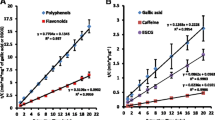Abstract
There is an increasing interest in the biological effects of natural antioxidants present in teas on formation ofin vivo free radicals, carcinogenesis, and atherogenesis. Teas are traditionally classified into six major groups, namely, green, yellow, white, black, dark-green, and oolong teas. The present study examined the antioxidative activity of ethanol extracts from these six major groups of teas against oxidation of heated canola oil. The oxidation was conducted at 100°C by monitoring oxygen consumption and changes in linoleic and linolenic acids in canola oil. The ethanol extracts of green, yellow, and white teas strongly inhibited oxidation of canola oil compared to butylated hydroxytoluene, probably due to the presence of natural polyphenols. In contrast, oolong teas examined exhibited only moderate antioxidative activity because of the partial destruction of natural polyphenols by semifermentation. The ethanol extracts of black, dark-green, and ginseng teas studied showed little or no protection to canola oil from lipid oxidation, probably due to the complete destruction of natural polyphenols by fermentation during manufacturing processes.
Similar content being viewed by others
References
Chen, Z.P.,Encyclopedia of Chinese Teas, Shanghai Culture Press, Shanghai, 1992, p. 386.
Stagg, G.V., and D.J. Millin, Nutritional and Therapeutic Value of Tea,J. Sci. Food. Agric. 26:1439–1459 (1975).
Graham, H.N., The Plant and Its Manufacture, inMethyl Xanthine Beverage and Foods: Chemistry, Consumption, and Health Effects, edited by G. Spiller, Alan R. Liss, New York, 1984, pp. 29–74.
Zhu, M., P.G. Qiao, P.P. Zhang, and W.H. Lu, Catechins in Green and Black Teas,J. Chinese Trad. Med. 17:677–678 (1992).
Hertog, M.G.L., E.J.M. Feskens, P.C.H. Hollman, M.B. Katan, and D. Kromhout, Dietary Antioxidant Flavonoids and Risk of Coronary Heart Disease,Lancet 342:1007–1011 (1993).
Renaud, S., and M. de Lorgeril, Wine, Alcohol, Platelets and French Paradox for Coronary Heart Disease,339:1523–1526 (1992).
Addis, P.B., Coronary Heart Disease, An Update with Emphasis on Dietary Lipid Oxidation Products,Nutrition Quarterly 14:43–47 (1990).
Kinsella, J.E., E. Frankel, B. German, and J. Kanner, Possible Mechanism for the Protective Role of Antioxidants in Wine and Plant Foods,Food Technology:85–89 (1993).
Frankel, E.N., J. Kanner, J.B. German, E. Parks, and J.E. Kinsella, Inhibitionin vitro of Oxidation of Human Low-Density Lipoproteins by Phenolic Substance in Wine,Lancet 341:1–4 (1993).
Stocks, P., Cancer Mortality in Relation to National Consumption of Cigarettes, Solid Fuel, Tea and Coffee,Br. J. Cancer 24:215–225 (1970).
Kono, S., M. Ikeda, S. Tokudome, and M. Kuratsune, A Case-Control Study of Gastric Cancer and Diet in Northern Kyushu, Japan,Jpn. J. Cancer Res. 79:1067–1074 (1988).
Oguni, I., K. Nasu, S. Yamamoto, and T. Nomura, The Antitumour Activity of Fresh Green Tea Leaf,Agric. Bio. Chem. 52:1879–1880 (1988).
Kinlen, L.J., A.N. Willows, P. Goldblatt, and J. Yudkin, Tea Consumption and Cancer,Br. J. Cancer 58:397–401 (1988).
Kapadia, G.J., B.B. Paul, E.B. Chung, B. Ghosh, and S.N. Pradham, Carcinogenicity of Camellia Sinensis (Tea) and Some Tannin-Containing Folk Medical Herbs Administered Subcutaneously in Rats,J. Natl. Cancer Inst. 57:207–209 (1976).
Bogovski, P., N. Day, M. Chvedoff, and F. Lafaverges, Accelerating Action of Tea on Mouse Skin Carcinogenesis,Cancer Letter 3:9–13 (1977).
Shi, S.T., Z.Y. Wang, T.J. Smith, J.Y. Hong, W.F. Chen, C.T. Ho, and C.S. Yang, Effects of Green Tea and Black Tea on 4-(methylnitrosamine)-1-(3-Pyridyl)-1-Butanone Bioactivation, DNA Methylation and Lung Tumorigenesis in A/J Mice,Cancer Res. 54:4641–4647 (1994).
Wang, Z.Y., M.T. Huang, Y.R. Lou, J.G. Xie, K.R. Reuhl, H.L. Newmark, C.T. Ho, C.S. Yang, and A.H. Conney, Inhibitory Effects of Black Tea, Green Tea, Decaffeinated Black Tea and Decaffeinated Green Tea on Ultraviolet B Light-induced Skin Carcinogenesis in 7, 12-Dimethylbenz(a) Anthracene-Initiated SKH-1 Mice,54:3428–3435 (1994).
Branen, A.L., Toxicology and Biochemistry of Butylated Hydroxyanisole and Butylated Hydroxytoluene,J. Am. Oil Chem. Soc. 52:59–63 (1975).
Ito, N., S. Fukushima, A. Hagiwara, M. Shibata, and T. Ogiso, Carcinogenicity of Butylated Hydroxyanisole in F344 Rats,J. Natl. Cancer Inst. 70:343–352 (1983).
Altmann, H.J., W. Grunow, U. Mohr, H.B. Richter-Reichhelm, and P.W. Wester, Effects of BHA and Related Phenols on the Forestomach of Rats,Food Chem. Toxic. 24:1183–1188 (1986).
Witschi, H., and C.C. Morse, Enhancement of Lung Tumor Formation in Mice by Dietary Butylated Hydroxytoluene: Dose-Time Relationships and Cell Kinetics,J. Natl. Cancer Inst. 71:859–866 (1983).
Linderschmidt, R.C., A.F. Trylka, M.E. Goad, and H.P. Witschi, The Effects of Dietary Butylated Hydroxytoluene on Liver and Colon Tumor Development in Mice,Toxicol. 38:151–160 (1986).
Xie, B., H. Shi, Q. Chen, and C.T. Ho, Antioxidant Properties of Fractions and Polyphenol Constituents from Green, Oolong and Black Teas, Proceedings of the National Science Council, ROC, Part B:Life Science 17:77–84 (1993).
Lunder, T.L., Catechins of Green Tea, inPhenolic Compounds in Food and Their Effects on Health II, edited by C-T. Ho, C.Y. Lee, and M.T. Huang, American Chemical Society, Washington, D.C., 1992, pp. 114–120.
Bunick, F.J., Lipid Autoxidation in Human Red Blood Cell Membrane, Ph.D. Dissertation, University of Massachusetts at Amberst, Massachusetts, 1984.
Chen, Z.Y., W.M.N. Ratnayake, and S.C. Cunnane, Oxidative Stability of Flaxseed Lipids During Baking,J. Am. Oil. Chem. Soc. 71:629–632 (1994).
Chen, Z.Y., G. Pelletier, R. Hollywood, and W.M.N. Ratnayake,Trans Fatty Acids in Canadian Human Milk,Lipids 30:15–21 (1995).
Duncan, D.B., Multiple Range and F-Tests,Biometrics 11:1–42 (1955).
Balentine, D.A., Manufacturing and Chemistry of Tea, inPhenolic Compounds in Food and Their Effects on Health I, edited by C.-T. Ho, C.Y. Lee, and M.T. Huang, American Chemical Society, Washington, D.C., 1992, pp. 102–117.
Author information
Authors and Affiliations
About this article
Cite this article
Chen, Z.Y., Chan, P.T., Ma, H.M. et al. Antioxidative effect of ethanol tea extracts on oxidation of canola oil. J Am Oil Chem Soc 73, 375–380 (1996). https://doi.org/10.1007/BF02523434
Received:
Accepted:
Issue Date:
DOI: https://doi.org/10.1007/BF02523434




